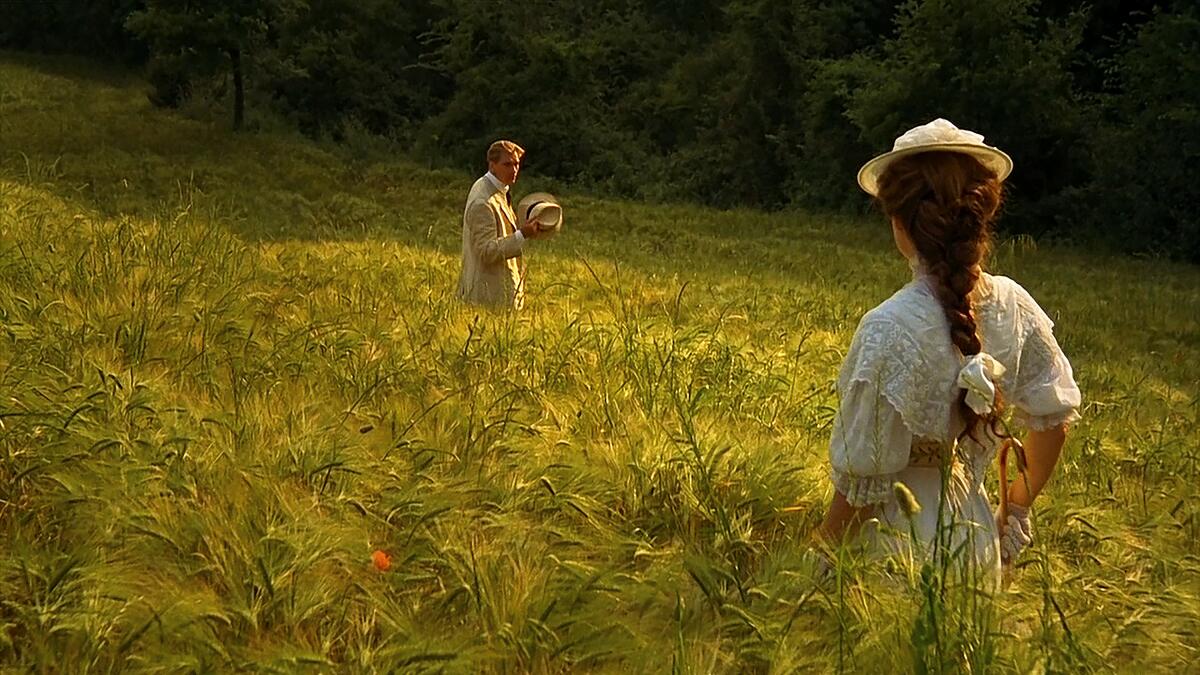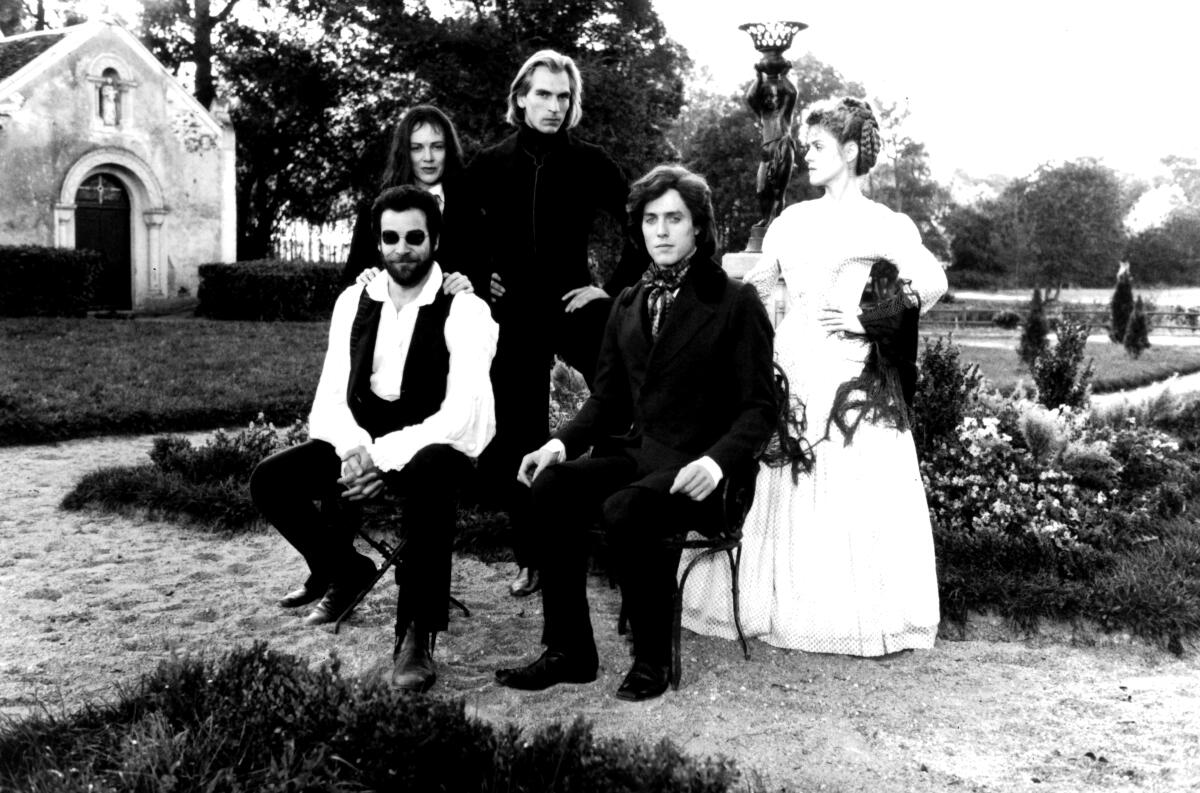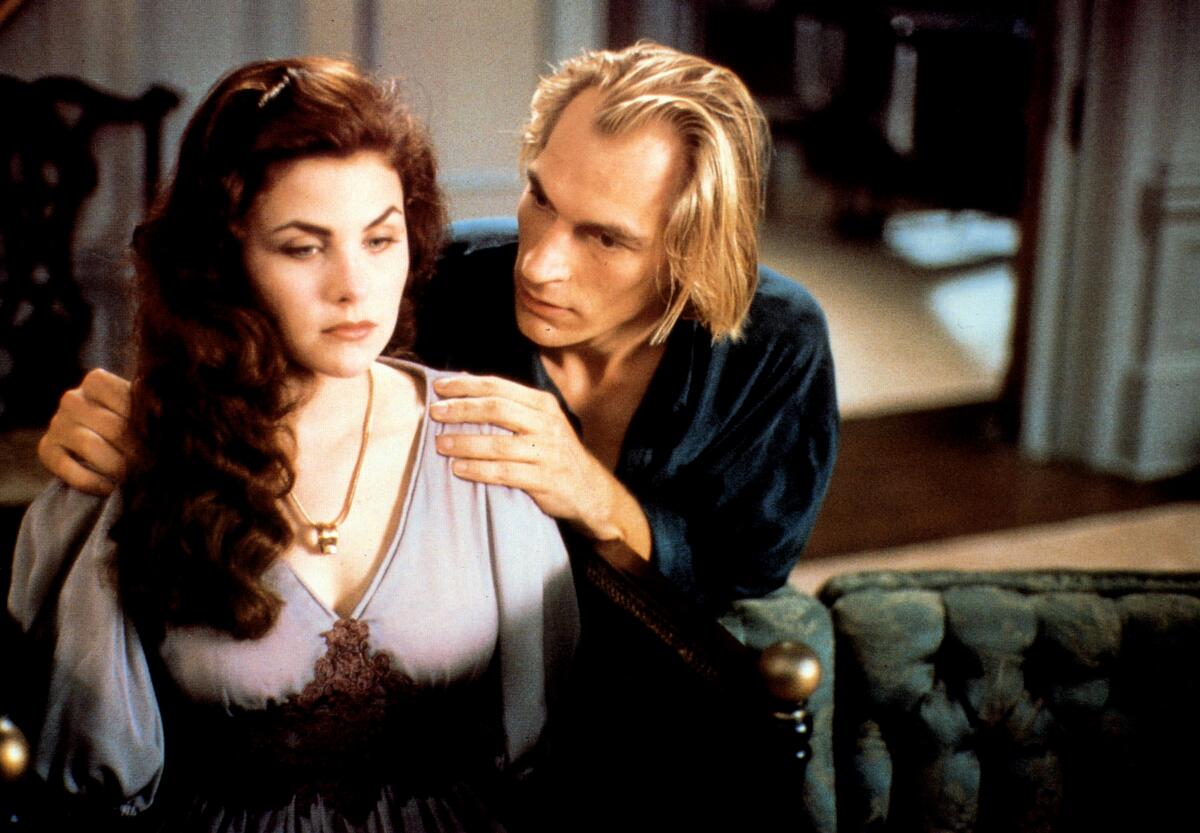Where you can (and can’t) watch eight of Julian Sands’ most notable movie roles

- Share via
Julian Sands, whose remains were found Saturday and identified this week five months after he went missing while hiking near Mt. Baldy, emerged in the 1980s with a cohort of other actors who rode a British cinematic rebirth to Hollywood stardom. Those peers and sometime co-stars included Hugh Grant, Daniel Day-Lewis and Richard E. Grant, a new wave-era succession to the Angry Young Men of the 1950s and ‘60s.
Tall and blond, with cheekbones that could cut glass, Sands projected a simultaneously rakish, dashing and villainous persona that rendered any character he played complex. He counted such Romantic period figures as Franz Liszt (“Impromptu”) and Percy Bysshe Shelley (“Gothic”) among his cinematic repertoire.
Equally adept at the gentility of Merchant-Ivory-Jhabvala (“Room With a View”) and the malevolence of “Warlock,” Sands charted an eclectic four-decade career that spanned movies and TV and included working with such edgy directors as David Cronenberg (“Naked Lunch”), Jennifer Lynch (“Boxing Helena”) and Mike Figgis (“Leaving Las Vegas”). Here are seven of Sands’ best-known roles and where to watch them, plus one that will require some sleuthing, along with previous coverage by The Times.
— Kevin Crust
‘The Killing Fields’
Kanopy | Apple TV + (Rent/Buy) | Prime Video (Rent/Buy)
1984 | 2 hours, 21 minutes | Rated R
“The Killing Fields” premiered [nearly 40] years ago as more than the first major film to explore the atrocities of Pol Pot’s reign of terror in Cambodia in the 1970s.
The film “changed my life,” said actor Sam Waterston, who earned an Oscar nomination playing New York Times reporter Sydney Schanberg, one of the few American journalists left in Phnom Penh when the city fell to Khmer Rouge guerrillas in 1975. Added Waterston: “I think it changed the lives of every single person involved in making it.”
That would include Haing S. Ngor, who won the Academy Award for supporting actor portraying Dith Pran, Schanberg’s translator and journalistic partner, as well as director Roland Joffé, who remains involved with Cambodian charities.
Rounding out the cast were John Malkovich as photojournalist Al Rockoff and Julian Sands as British journalist Jon Swain. Sands said the director sent the actors to Thailand a month before shooting started so they could become immersed in the place and the truth of the story.
“I remember the profound impact of visiting the Khmer refugee camps on the Thai-Cambodian border and talking to survivors about their experiences with Haing Ngor as translator,” said Sands. (Read more of Susan King’s 2014 feature story)

‘A Room With a View’
Max | Apple TV + (Rent/Buy) | Prime Video (Rent/Buy)
1985 | 1 hour, 57 minutes | Not Rated
During dinner at the pensione in Florence where the young, full-lipped, spirited Lucy Honeychurch is visiting, corseted in propriety by the presence of her maiden cousin Charlotte Bartlett, a message is sent — for Lucy’s eyes alone. Unconventional George Emerson, a fellow Englishman about her age and her equal in glowing handsomeness, has spelled out on his plate an enormous question mark in peas and potatoes.
Don’t be mistaken. This is no delightfully ingenious pickup. It is 1907, after all; and George is wrestling with nothing less than Life’s Great Question, the everlasting Why.
So begins the airy, delectable Merchant-Ivory-Jhabvala adaptation of E.M. Forster’s thoughtful romance “A Room With a View,” his third and most beckoningly readable novel, which has been made into a virtually irresistible film.
Lucy (Helena Bonham-Carter) is the silken center of it all. Gloweringly pretty, with thickets of hair and a well-placed, though not aristocratic country family, she seems deceptively demure, a proper flower of Edwardian England. But let her sit at the piano to rip into some of the Beethoven sonatas and something astonishing emerges.
In the square at Santa Croce, Lucy and the questioning George (Julian Sands, the blond photographer of “The Killing Fields”) are witnesses to a sudden, bloody and random act of violence (staged so that all those elements act upon us as vividly as they do on the characters.) It’s a galvanic moment, and George recognizes it. He knows with certainty for the first time that given a choice between life and death, he will now choose life. And Lucy. (Read more of Sheila Benson’s 1986 review)
British actor Julian Sands, known for ‘A Room With a View’ and ‘Warlock,’ was found dead after going missing in the San Gabriel Mountains in January.
‘Warlock’
Freevee (with ads) | Tubi (with ads) | Apple TV + (Buy) | Prime Video (Buy)
1989 | 1 hour, 43 minutes | Rated R
Released internationally in 1989, the film did not reach U.S. theaters until 1991. The 1993 sequel, “Warlock: The Armageddon,” is available on the same platforms.
The devil finds work for idle hands. While watching “Warlock,” (citywide), a supernatural shocker about “Satan’s son” running amok, you may wish those hands had been much idler.
The movie begins in Boston, during the witch hunts, a social phenomenon of which the filmmakers seems to approve, and time-warps over to modern Los Angeles and back to Boston. Yet, during all of its demonic high jinks — the trail of eye-gougings and child-murders which the killingly suave warlock leaves in his wake — not a trace of originality is allowed to interfere.
No wit or humanity, or even any genuine horror, intrudes on the mechanical chases, the plastic plot twists. We are not in Milton’s or Dante’s infernos, but something more mundane: Satan-Land as it might have been envisioned for a Coral Gables fun-fair.
The basic story is somewhat like “The Terminator,” with villain and pursuer emerging from the past rather than the future. The variations are uninspired, lusterless. Whenever director Steve Miner and writer D. T. Twohy sense boredom, they chop off a finger, bite off somebody’s tongue or tear open a grave.
Actors Julian Sands (the Warlock) and Richard E. Grant (his Witchhunter) deliver their over-fruity lines with the fervor of Shakespearean hams spraying everybody in the first five rows. The cinematography is drab and dark, even in daylight, and the special effects seem almost shy. Only Jerry Goldsmith’s music, crashing away as it has from “The Omen” on, generates any real tension. (Read more of Michael Wilmington’s 1991 review)
What to watch, where to watch it and why it matters: Read the 16 stories in our Ultimate Guide to understand the state of streaming services in 2023.
‘Arachnophobia’
Apple TV + (Buy) | Prime Video (Rent/Buy)
1990 | 1 hour, 49 minutes | Rated PG-13
Goodbye “Charlotte’s Web,” hello “Arachnophobia.” Fair warning, too, for all of us who’ve retrained our reflexes so that we don’t double over and stamp at the floor hysterically at the sight of “a harmless little spider.” In Frank Marshall’s funny-scary primal scream of a comedy, there is no such thing--this king-pin spider shoulders his way through doggy doors and when he crawls up inside the bedcovers, it’s like watching the rippling progress of a Siamese cat.
Yet, because of the film’s light touch and the warmth with which it treats a revered form--the ‘50s horror movie--”Arachnophobia” manages to be genuinely frightening without being ‘80s-style revolting. There are no chest-busters here, dripping saliva that can pit the plates of a battleship. Marshall has gauged his pattern of frights and laughs carefully, to let the audience giggle at its own jumpiness, and his cast, which includes a sprinkling of the best-known American character actors, is a clue to his affection for the form.
It is the classic form, done on a grander scale: the blob/Martian/ spider from far, far away that very nearly wipes out the perfect American small town. Marshall’s attraction for its unyielding conventions is hardly surprising, his debut as a director comes after years as Steven Spielberg’s co-producer and both men seem to love the predictable pleasures of the B-movies and the Saturday matinee serials.
However, if the screenplay by Don Jakoby and Wesley Strick, from a story by Jakoby and Al Williams, is an homage, it’s an updated one. We may have the usual earnest scientist (Julian Sands) to lead us to the lair of the unthinkable, “a place where species have survived in isolation for millions of years.” On the other hand, we have a very contemporary hero (a dryly humorous Jeff Daniels), unmacho enough to yell to his kids, “We need mom in here to kill a spider.” (Read more of Sheila Benson’s 1990 review)

‘Impromptu’
Hoopla | Ovid | Roku Channel (with ads) | Tubi (with ads) | Apple TV + (Rent/Buy) | Prime Video (Rent/Buy)
1991 | 1 hour, 47 minutes | Rated PG-13
Judy Davis is such a powerful actress that, like Bette Davis and Katharine Hepburn before her, she requires roles that do justice to her fierceness. She demands great roles.
In “Impromptu,” Davis plays George Sand, the most popular and notorious female writer of the early 19th Century. It ought to be a great role for her but the movie is too shallow and flighty to do her justice.
Sand was more than a great writer; she was a central figure in the Romantic whirligig that also included Liszt, Chopin and Delacroix. And her love life was as pronounced a part of her celebrity as her writings. Sand’s career was a marvel of prodigiousness. Not only did she turn out nearly a hundred volumes of prose, but she also found the time to cut a swath through an imposing number of high-profile lovers, including her famous eight-year liaison with Chopin.
The Chopin affair is at the center of “Impromptu.” For a while at the beginning of the movie, when Sand is prowling the halls of Liszt’s home, listening in on Chopin (Hugh Grant) behind closed doors as he tinkles the ivories, the film has a camp sprightliness. Most movies about famous artists are such artery-hardening affairs that the initial offhandedness is tonic.
It turns out to be too offhanded, too lightweight for the heavyweights involved.
The film’s musical-without-portfolio quality may owe something to the fact that it was directed by James Lapine, the librettist-director of Stephen Sondheim’s “Sunday in the Park With George” and “Into the Woods.” Lapine, making his feature film debut, doesn’t have the technique to turn this amatory whirl into a lyrical roundelay. When he introduces the music of Chopin and Liszt (Julian Sands) into the proceedings, the effect isn’t revelatory, it’s discordant. It’s impossible to believe that such sounds could have issued from such twits.
“Amadeus” may have paved the way for this nincompoop-genius approach. “Impromptu” isn’t quite as rollicking as that film, though. Its geniuses, particularly Chopin, are still caught between conscious, high-flying camp and an older, more tortuous theatrical tradition — the Master Thespian tradition that requires a famous artist to look blazingly into the future while coughing despondently into his handkerchief. (Read more of Peter Rainer’s 1991 review)
‘Naked Lunch’
Cinemax (via Amazon Prime); Criterion Collection Blu-ray (Buy)
1991 | 1 hour, 55 minutes | Rated R
David Cronenberg may have seemed like the perfect director to adapt William Burroughs’ pop phantasmagoria “Naked Lunch,” which was published in 1959. The book presages much of what Cronenberg has done in the movies; it’s clearly as much of an influence on him as it has been for such directors as Nicolas Roeg or Ridley Scott. Its dope-drenched, bug-house atmosphere, with the dream-like narrative spliced into glittery shards, is tailor-made for a director as attuned to the gloppiness of interior states as Cronenberg.
But how do you make a movie out of Burroughs’ carnal psychedelia? Cronenberg himself has been quoted as saying, “It’s impossible to make a movie out of ‘Naked Lunch.’ A literal translation just wouldn’t work. It would cost $400 million to make and would be banned in every country in the world.”
Now that’s the movie some of us still want to see!
What Cronenberg has done instead is to concoct a hallucinatory jag about the tortuous process Burroughs went through in creating “Naked Lunch.” There are enough references to the novel, enough episodes and characters, to provide a glancing resemblance to the original. But mostly, Cronenberg jacks up his own career-long obsessions with glop and grunge and decay to fever pitch. It’s a movie for people who really dig Cronenberg’s mulchy fixations — and probably for no one else.
Cronenberg does have an eye for more than insects; he tends to cast his people primarily for their physical qualities, as if they, too, were specimens. Peter Weller, with his gaunt ghostliness and gray fedora, is an apt Burroughs stand-in; Scheider, who has a somewhat reptilian glaze anyway, scores as the bug-poison doc; Davis preserves her hawk-like intensity in the midst of the splattery rumpus, and Julian Sands, playing a Swiss lech, has an avidity for depravity that makes him the natural hero of his scenes. He’s a true sci-fi protagonist: demented and impossibly obscene. (Read more of Peter Rainer’s 1991 review)

‘Boxing Helena’
Not currently available to stream; specialty video stores may have the out-of-print DVD
1993 | 1 hour, 47 minutes | Rated R
It was probably worth every costly cent for Kim Basinger to get out of doing the dreadful “Boxing Helena” — but you have to wonder whatever there was about it that persuaded her to consider doing it in the first place.
Julian Sands, his pronounced British accent unexplained, stars as Dr. Nick Cavanaugh, a chief surgeon in an unnamed North American city who as a child was extolled to work hard — and was simultaneously taunted by his sexy, amoral mother who flaunted her open nudity and casual affairs. When the mother dies, the doctor is all set to put her elegant mansion up for sale when he encounters the gorgeous but haughty Helena (Sherilyn Fenn), with whom he had once had a one-night stand and is now absolutely transfixed by her.
An awkward pursuit ensues, with her rushing out of the mansion and into the street, where she is struck by a car. When she regains consciousness she finds her legs have been amputated and that she has become the doctor’s prisoner. That he does not yet feel she is sufficiently dependent upon him is made overwhelmingly clear by repeated foreshadowing shots of a replica of the armless Venus de Milo.
In her directorial debut, Jennifer Chambers Lynch, who also wrote the script from Philippe Caland’s story, reveals her filmmaker-father David Lynch’s taste for the bizarre without any of his darkly perceptive humor and sense of style. “Boxing Helena” has been filmed with the straightforwardness of a standard TV movie, which means that it lapses swiftly into a protracted exercise in morbidity and silliness ending in a creaky cop-out device almost as old as the movies themselves. (Read more of Kevin Thomas’ 1993 review)
‘Leaving Las Vegas’
Showtime | Apple TV + (Rent/Buy) | Prime Video (Rent/Buy)
1995 | 1 hour, 51 minutes | Rated R
Sands co-stars as a sadistic pimp named Yuri.
“Leaving Las Vegas” is a film laden with virtues but difficult to embrace. Beautifully put together, sensitively acted by Nicolas Cage and Elisabeth Shue, directed by Mike Figgis with assurance and style and making exceptional use of its musical score, this doomed romance is finally not as satisfying as all of that would have you believe.
One reason is an obvious one, intentionally crafted by the filmmakers themselves. The uncompromisingly downbeat story of a love affair between a hard-luck prostitute and a man hellbent on drinking himself to death, “Leaving Las Vegas” is one of the bleakest romances in memory, a totally despairing film, complete with a wrenchingly explicit scene of anal rape, that is shrouded in a miasma of hopelessness. If this is what great romance means, audiences may feel like settling for whatever’s in second place. (Read more of Kenneth Turan’s 1991 review)
More to Read
Only good movies
Get the Indie Focus newsletter, Mark Olsen's weekly guide to the world of cinema.
You may occasionally receive promotional content from the Los Angeles Times.












